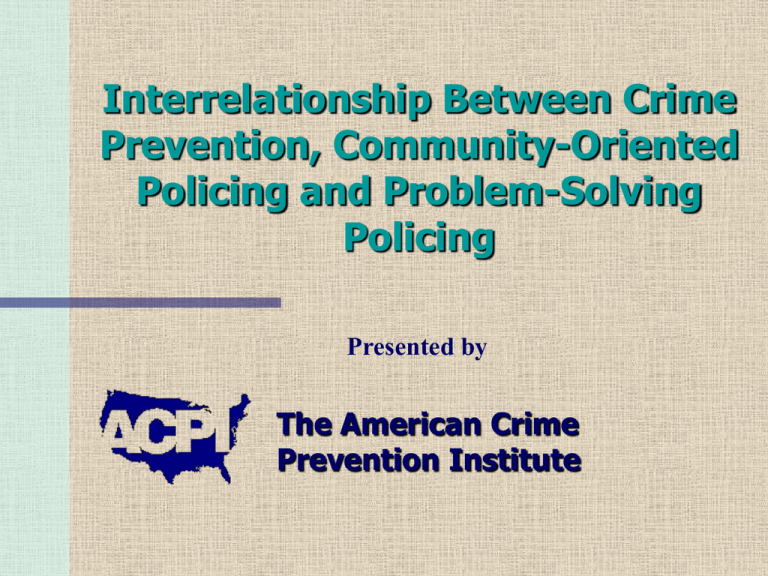Interrelationship Between Crime Prevention, Community & Policing
advertisement

Interrelationship Between Crime Prevention, Community-Oriented Policing and Problem-Solving Policing Presented by The American Crime Prevention Institute Crime Prevention Involves the Minimizing or Reducing of Opportunities and/or the Desire to Commit Crime Involves Programs to Prevent Both Criminalization and Victimization Involves Active Participation With the Community Requires a Cadre of Trained, Experienced Specialists John C. Klotter - University of Louisville - National Crime Prevention Institute Should Involve as Many Officers as Possible in a Department Crime Prevention Can Be Practiced Independently From Community-Oriented Policing and Problem-Solving Policing Crime Prevention Provides Knowledge About How to Prevent Specific Types of Crimes, How to Engage Members of the Community in Prevention Efforts and How to Develop Physical and Social Environments Inhospitable to Crime. Crime Prevention Serves as a Tool With Which to Implement Community-Oriented Policing Crime Prevention Efforts Provide Information and Skills that Are Essential to Community Policing Community-Oriented Policing Community-Oriented Policing Is A Philosophy Of Policing Based Upon the Concept That Police Officers and Citizens Can Work Together in Creative Ways to Solve Problems Related to Crime and the Fear of Crime. Community Policing Is An Attitude or Philosophy of Being Part of the Community in Which You Work It Is an Attitude of Serving, Not Controlling the Public Community Policing Is a Philosophy of Being Responsive to the Public's Needs and Concerns Community Policing Is a Philosophy of Addressing the Public's Problems and Responding to Those Things They Believe Are Important, Not Always What We As Police Believe Is Most Important Community-Oriented Policing Requires That We as Police Again Become Part of the Community and Use the Community as a Resource Community Policing Involves Daily, Face-to-Face Contact With Members of the Community The Community Has Input into the Police Agenda - Community Policing Survey Robert Trojanowicz, School of Criminal Justice, Michigan State University Community-Oriented Policing Ideally Involves all Members of the Department The Ultimate Goal of Community Policing Is the Prevention of Crime While It Is Possible to Have Crime Prevention Without a Community Policing Focus, You Cannot Have Community Policing Without Crime Prevention Crime Prevention Is the Tool to Implement Community Policing Efforts Community Policing Encourages Officers to Experiment With Creative and Innovative Solutions Aimed at Community Problems. In Community-Oriented Policing, the Community Has More Input into the Police Agenda Than in Crime Prevention. Community Policing Relies on Organizational Decentralization and a Reorientation of Uniformed Patrol to Facilitate Two-Way Communication Between the Police and the Public Community Policing Shifts the Focus of Police Work From Handling Random Calls to Solving Community Problems Community Policing Encourages Geographical Ownership by the Police What Led to Community Policing? Isolation of Police Officers in Police Cars The Narrowing of the Police Mission to Crime Fighting Problem-Solving Policing Consists of Analyzing Groups of Incidents, Identifying the Underlying Circumstances That Create Them and Then Devising Solutions by Using a Wide Variety of Public and Private Resources What Is a Problem? A Cluster of Similar, Related or Reoccurring Incidents Rather Than a Single Incident A Substantive Community Concern A Unit of Police Business Approaches to Problem-Solving Policing Concentrate Attention On Those Individuals Who Account For a Disproportionate Share of a Problem Connect With Other Government or Private Services - Referral to Another Agency Correct Inadequacies in Local Services and Pressing For New Services - Improved Lighting, For Example Using Mediation and Negotiation Skills Conveying Information Mobilizing the Community Altering the Physical Environment to Reduce Opportunities for Problems to Occur Increasing Regulations, Through Statutes or Ordinances, of Conditions That Contribute to Problems Problem-Solving Policing Can be Done Without a Commitment to Community-Oriented Policing, but Community-Oriented Policing Cannot be Done without a Commitment to Problem-Solving Policing Herman Goldstein, University of Wisconsin at Madison, Founder Of P.O.P. Problem Solving Process Identify the Problem Analyze the Problem Recommendations to Alleviate the Problem Follow Through Assessment Possible Problem-Solving Areas Neighborhood Crime Problem Safety-Related Problem (RR Crossing) Vandalism - Graffiti Traffic-Related Problem Youth Activity Problem THANK YOU The American Crime Prevention Institute is a division of the AEGIS Protection Group, Inc.







